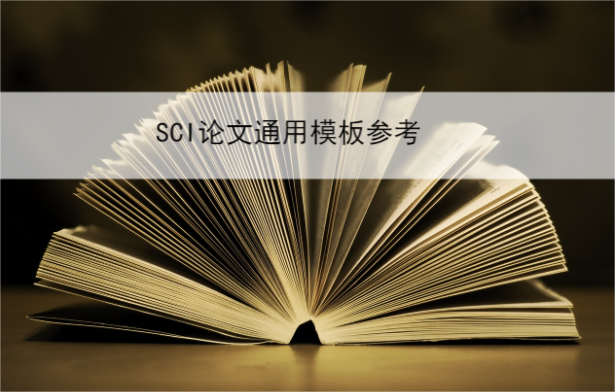免费的SCI论文基础通用模板,拿走不谢!
时间:2023年11月13日 分类:SCI论文百科 次数:
对科研小白来说,看到SCI期刊的各类投稿要求,难免会比较头大,但掌握基本规则,学习相应的模板,也可以轻松应对。所有SCI期刊基本是大同小异,基本的SCI论文结构包括以下内容:标题、作者、摘要、关键词、引言、方法、结果、讨论、结论、致谢、参考文献、表格、插图等。

Title
[Titles do not exceed two lines in print. This equates to 75 characters (including spaces). Titles do not normally include numbers, acronyms, abbreviations or punctuation.]
经验总结: 标题不要太长,注意尽量控制在两行,大约75个词以内(包括空格)。通常注意避免使用阿拉伯数字、缩写、缩略语、代号或标点符号。
Author Information
[Authors' full first and last names and complete address information including city, zip code, state/province, and country must be provided. Ensure that the author order and all author information are correct. Updates to author information may not be permitted after submission or acceptance.
At least one author should be designated as the corresponding author. Authors who have contributed equally should be marked and stated.]
Firstname Lastname 1, Firstname Lastname 2, Firstname Lastname 2,*
1 Affiliation 1, City, State/Province, Country, Zip code
2 Affiliation 2, City, State/Province, Country, Zip code
* Correspondence: e-mail@e-mail.com
经验总结:必须提供作者的全名和姓氏以及完整的地址信息,包括城市、邮政编码、州/省和国家。
确保作者顺序和所有作者信息都是正确的。提交稿件、修改稿件过程中或通知文章接收后,也就是一旦投稿后,都尽量不要再增减或修改调整作者信息,否则有可能被拒稿。如果必须要进行作者的相关调整,一定要有非常充足的支持理由,并且一定要提前跟编辑联系沟通好,再进行相关操作,切忌先斩后奏!
Abstract
[A pertinent overview of the work about 150-250 words, separated by the headings below:]
Background: Place the question addressed and highlight the purpose of the study.
Methods: Briefly describe the main methods or treatments applied.
Results: Summarize the article’s main findings.
Conclusions: Indicate the main conclusions or interpretations.
经验总结:对论文研究内容的总体概述,约150-250个词,按以上四大块标题内容分开来写更容易:研究背景、方法、结果发现、主要结论。大部分期刊对摘要的要求是一段150-250词的段落,但有一些期刊的要求比较特殊(比如BMC系列期刊),它们的摘要由Background,Results,Conclusions三部分构成。
Keywords
[List 3-10 pertinent keywords specific to the article yet reasonably common within the subject discipline.]
keyword 1; keyword 2; keyword 3; keyword 4; keyword 5
经验总结:列出3-10个文章内容相关的关键词,在该学科中比较常见的、容易被检索到的,关键词是对标题内容的补充,选词尽量与标题有所区别。
Introduction
[Define the purpose of the work and its significance. The current state of the research field should be carefully reviewed and key publications cited. Highlight controversial and diverging hypotheses when necessary. Finally, briefly mention the main aim of the work and highlight the principal conclusions.]
经验总结:引言部分是陈述你研究工作的目的和意义。应仔细审查你研究领域的现状,并引用重要关键的参考文献。必要时突出有争议的和有分歧的假设。最后,简要提及你研究工作的主要目标,并强调主要结论。这个部分是论文查重的必“争”重地,引用研究领域现状的关键文献时,一定不要原文原句照搬式引用,要用自己的话总结出来引用。
Materials and Methods
[Written concisely but should contain all elements necessary for interpretation and replication of the results.
Subdivide by short, bold headings referring to each part of the methods used.
Manuscripts reporting large datasets that are deposited in a publicly available database should specify where the data have been deposited and provide the relevant accession numbers.
Interventional studies involving animals or humans, and other studies that require ethical approval, must list the authority that provided approval and the corresponding ethical approval code.]
Materials/Methods subheading 1
Materials/Methods subheading 2
经验总结:材料方法这个部分需要注意如果要发表的数据量比较大,且存放在公共数据库中,应明确说明可获取数据的存放地点,并提供相关的登录号可供查阅。如果研究内容涉及动物或人类以及其他需要伦理批准的情况,必须列出提供伦理批准的机构和相应的伦理批准代码。
Results
[Provide a concise and precise description of the experimental results, their interpretation, as well as the experimental conclusions that can be drawn.]
Results subheading 1
Results subheading 2
经验总结:简明、准确、客观地描述出你研究的实验结果、结果对应的相关解释以及可得出的实验结论。
Discussion
[Discuss the results and how they can be interpreted from the perspective of previous studies and of the working hypotheses. Limitation of the current study and future research directions may also be highlighted.]
经验总结:讨论部分是针对论文结果进行展开,重点关注如何从以前的研究和工作假设的角度解释现有的实验结果,是为最终得出可靠结论做铺垫。同时,讨论中还可以强调当前研究的局限性和未来的研究方向。
Conclusions
[Summarize the main conclusions or interpretations.]
经验总结:总结主要结论或解释。注意不要和摘要“撞衫”,要各自“美丽”。
Acknowledgments
[Acknowledge any support or assistance given not covered by the author contribution or funding sections.]
经验总结:鸣谢作者贡献或支持资金部分未涵盖的任何支持或帮助。
References
[Prepare and insert/cite the references with EndNote bibliography software to avoid typing mistakes and duplicated references.
Number the cited references in order of appearance in the text (including citations in tables and legends) and listed individually at the end of the manuscript.
Include the digital object identifier (DOI) for all references where available.]
经验总结:建议采用各种小工具,例如用EndNote软件来插入/引用参考文献,以避免输入错误和重复引用。
按文中出现的顺序对引用的参考文献进行编号(不要忘记:包括表格和图例中的引用),这个部分通常在稿件正文的末尾单独列出。
建议在一开始就把具有DOI的参考文献的DOI都一起准备好,现在基本上所有期刊都要求需要附上。
Tables
[All tables should be cited in the main text as Table 1, Table 2, etc.
List tables after the References section.
Complex tables can be submitted as a separate Excel file.
Include a brief explanatory title for each table
All table columns should have an explanatory heading.]
经验总结:所有的表格都应在正文中以表1、表2等形式引用。在参考文献部分之后列出表格。如果你的表格比较复杂,建议作为一个单独的Excel文件提交。注意:每个表格都必须有一个简短的解释性标题,表格里每一栏也都应该有一个解释性的标题。
Figures
[All figures must be cited in sequence within the main article text in the form Fig. 1, Fig. 2, etc.
Use a 5–7 pt San Serif font for standard text labelling and Symbol font for Greek characters.
Use scale bars, not magnification factors, and include error bars where appropriate.
Each Figure must be provided during submission in a single file in formats of TIFF, JPEG, or EPS at a sufficiently high resolution (minimum 1000 pixels width/height, or a resolution of 300 dpi or higher).
Include a brief caption for each figure with a short description of each panel cited in sequence.
Include a description of median or average and all error bars and how they were calculated.
Give an indication of sample size (n number), state the statistical test used and provide P values.]
Figure 1. A brief caption. A short description of each panel.
Figure 2. A brief caption. A short description of each panel.
经验总结:所有插图必须在文章正文中有所对应,并按顺序引用,形式为图1、图2等。插图中的文本标记通常使用5-7pt San Serif字体,希腊字符使用Symbol字体。
注意:插图一定要保证清晰度和可读性。每张图在提交时必须以TIFF、JPEG或EPS格式的单个文件提供上传,并具有足够高的分辨率(宽度/高度至少1000像素,或300dpi或更高的分辨率)。插图中使用比例条,而不是放大系数,在需要的地方使用误差条。每个图都有单独的一个简短说明描述作为标题。
最后提醒大家:当作者选定好期刊以后,还是要根据期刊的投稿格式进行修改和删减。利用这套通用模板,主要是可以提高定稿排版时的效率,更重要的是帮大家理清一篇SCI论文的主要构成和写作思路。
如果觉得上述模板并不适合您,也可以联系在线学术顾问,结合您所在专业,所需要的期刊,分享期刊对论文具体的格式要求,以及期刊的征稿范围,这样论文更容易录用、检索。
SCI论文
- 2024-02-26SCI论文是全文收录吗
- 2024-07-17sci一区论文可以保研吗
- 2024-08-16三类及以上期刊是什么
SSCI论文
- 2023-06-14发ssci论文能查到吗查询流程
- 2023-11-1140本人力资源管理方向的ssci期刊
- 2023-04-07公共管理方向可以发ssci刊物吗
EI论文
- 2023-08-22计算机方向被ei检索的会议多吗
- 2023-10-13ei论文查重高怎么降低
- 2023-03-28EI收录的都是英文期刊吗
SCOPUS
- 2023-12-25艺术教育论文可以发到scopus吗
- 2023-06-16scopus检索流程(方法)
- 2023-03-08ssci期刊和scopus期刊有交叉吗
翻译润色
- 2023-05-11生物医学sci论文润色有用吗
- 2024-08-16国际中文期刊发表论文应该用什么
- 2024-08-17英文论文怎么降重
期刊知识
- 2022-02-18有机材料相关论文发英文普刊能用
- 2020-12-26能源领域学术期刊影响力大的期刊
- 2022-10-09环境类英文期刊选择方法
发表指导
- 2019-04-16论文审稿过程中能催稿吗如何催稿
- 2020-07-22农艺师评高级有什么要求条件
- 2020-03-06肾脏病学统计源核心期刊有哪些